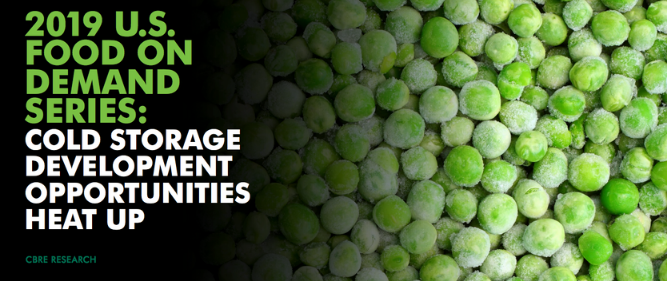Growth in online grocery sales is stoking demand for cold storage facilities across the United States, according to a new research report from CBRE. The real estate services and investment firm found that up to 100 million square feet of additional capacity is needed to meet online sales through 2022.
However, the cost and complexity of cold storage construction could make meeting that demand difficult. The resulting shortage will likely cause cold storage to become an even more coveted real estate asset – and those willing to invest in the market stand to reap major rewards.
Read below for the top insights from CBRE’s latest cold storage report.
Why refrigerated space is currently limited
Nearly all of the cold storage space that exists today is already being used. Occupiers of refrigerated warehouses rarely leave or relocate. In fact, cold storage has a historically low vacancy rate of 4.3%, and it’s even lower in competitive markets.
At the same time, cold storage development isn’t keeping up with demand. CBRE estimates about 4.5 million square feet of new cold storage construction has been recently completed or is underway. This represents just 1.5% of current industrial construction in the U.S.
In part, this is due to how rare speculative development is for refrigerated warehouses because of their unique complexities, a lack of experienced contractors, and the challenges in re-purposing facilities for other uses. However, the surging demand for cold storage is making investors re-evaluate the market.
Differences between cold storage and dry warehouses
The CBRE report compares refrigerated and dry warehouses to better understand cold storage construction. Key differences include:
Investment
Although costs vary widely based on factors like land values, labor and customer specifications, on average cold storage construction costs 2-3 times as much as a traditional dry warehouse. Temperature-controlled facilities need a thermal envelope, insulated panels and other advanced machinery not required in a dry warehouse. This building complexity also means the construction timeframe is usually four to five months longer.
Machinery and equipment
Cold storage facilities generally must be kept at temperatures within -25 to 55 degrees Fahrenheit. Maintaining these temperatures requires various structural and mechanical installations. Cooling systems include compressors, condensers and evaporators. The cold storage design must also have enhanced wall and roof insulation to reduce heat loss/gain, temperature/air-proof doors and temperature monitoring systems.
Layout and design
The layout of a cold storage facility is generally more complex as well. The main storage areas of the building may be divided into several temperature zones with prefabricated insulated metal panels. The separate rooms have distinct temperature and humidity ranges and sometimes even separate docking, loading and sorting areas.
In terms of design, cold storage warehouses typically have clear heights of 40 – 60 feet. The tall buildings increase pallet capacity, as well as reduce real estate costs due to a smaller footprint. Additionally, the facility design must comply with high building standards, such as fire protection, wind forces and local zoning, to name a few. Property managers not only have to deal with local building codes and regulations, but also with the EPA, OSHA, USDA and potentially the FDA.
Major trends that will impact cold storage
CBRE forecasts three major shifts that will change construction of cold storage in the coming years.
1. More speculative development
Developers will have to construct more projects on spec, meaning starting work without a tenant signed up. While currently rare, speculative development will be critical in meeting consumer demand.
2. Growth in small markets
Most cold storage construction takes place in large metro areas, but rising land and construction costs will push developers toward smaller markets near large population centers.
3. Increased automation in design and operation of facilities
Major retailers are already automating many of their cold storage processes to increase efficiency and reduce costs. Automated technology will be an important part of designing and upgrading facilities.
How an experienced design-build firm maximizes your investment
As the CBRE report stresses, it’s important to work with a developer or design-builder with expertise in refrigerated facilities. They will help you in navigating the unique challenges and opportunities presented by cold storage construction, as well as evaluate automation and design options that will help you achieve ROI more quickly.
At Stellar, we believe the design-build approach is key to overcoming many of the cold storage challenges presented in the report. With our design and construction teams working under one roof, Stellar can fast-track projects, streamline communication, and ultimately save our clients time and money.
Click here to download the full CBRE report. Comment below or email foodforthought@stellar.net to learn more about cold storage construction.



